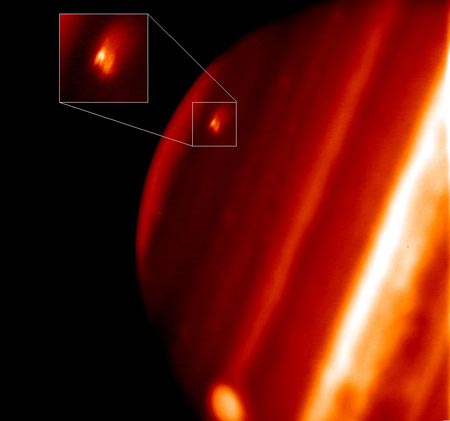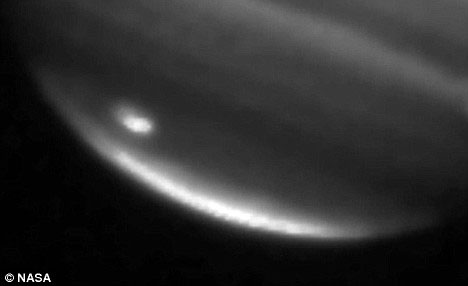Jupiter was carved by the castle
A large object just rushed into Jupiter and left a hole as large as the earth in its atmosphere, the US Aerospace Agency (NASA) said.
Anthony Wesley - an amateur astronomer in Australia - accidentally discovered the hole at 13:30 (GMT) on Thursday last week. He sent an e-mail to NASA scientists to announce the incident. After reviewing, NASA excluded the possibility that a certain weather event caused " huge black wounds " in Jupiter's atmosphere.
" The first picture of the gap and we captured it was made up of a collision. Maybe a giant meteorite or ice block hit Jupiter, " said Glenn Orton, a NASA expert. , comment. Orton observed the hole for 6 hours with infrared telescopes in Hawaii.

Photos taken with infrared cameras show that the new hole has a greater brightness than the surrounding area.(Photo: NASA)
This is the second time a giant dent appears in Jupiter's atmosphere. 15 years ago scientists had seen the same dent on this planet after 21 fragments of Shoemaker Levy 9 comet struck it. This gap only lasted 2-3 weeks and disappeared.
Images published by NASA show that the collision occurred near the southern pole of Jupiter and debris splashed onto the highest atmosphere. The hole was brighter than the surrounding area, so it was deduced that the collision increased the temperature of the air layer below. Because they did not witness the collision, scientists could not determine the size and mass of the celestial body that plunged into Jupiter. However, based on the size of the hole, they assumed that the object was much smaller than the globe. It may have moved at a speed of 50-100 km / s when plunging into Jupiter.

The hole is as big as the earth and near the southern pole of Jupiter.(Photo: NASA)
" At that tremendous speed, the celestial body will produce tremendous energy when it collides with any object in the universe. The new gap has not been around for long - perhaps a week or two ," Wesley said .
Jupiter is the largest big planet in the solar system and is located in the fifth position from the sun. Its atmosphere consists of about 86% hydrogen (H 2 ), 14% helium (He) and many other gases. Jupiter has a relatively small stone core compared to its size. Just above the core there is a layer of hydrogen gas in the solid body that has a metallic-like property. Next is the hydrogen gas layer in liquid and gaseous form. There are no clear boundaries between the three layers of gas because the distortion from one body to another is continuous.
- Overview of Jupiter
- Difficult mystery story in Edinburgh castle
- Visit the world's most beautiful castles
- Secretly discovered in the medieval castle
- For the first time, humans can discover Jupiter's deepest mystery
- The Juno probe sends the first image of Jupiter to Earth
- What happens if Jupiter doesn't exist?
- Tonight is the best time to see Jupiter
- Jupiter and Saturn will shine beautifully in the sky from today
- Jupiter once swallowed 10 times the planet Earth
- A series of wonderful images of Jupiter are sent from the Juno-NASA ship
- The room places the throne in the ruins of an old castle
 Van Allen's belt and evidence that the Apollo 11 mission to the Moon was myth
Van Allen's belt and evidence that the Apollo 11 mission to the Moon was myth The levels of civilization in the universe (Kardashev scale)
The levels of civilization in the universe (Kardashev scale) Today Mars, the sun and the Earth are aligned
Today Mars, the sun and the Earth are aligned The Amazon owner announced a secret plan to build a space base for thousands of people
The Amazon owner announced a secret plan to build a space base for thousands of people